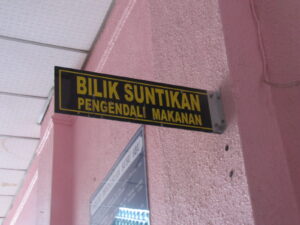The Food Safety and Quality Control Unit in Kuala Muda DHO.
Under which the acts and regulations that are followed are:
- Peraturan-peraturan (Perluasan pemakaian akta makanan 1983 bagi tembakau dan lain lain) makanan
- Peraturan-peraturan kawalan hasil tembakau
- Peraturan-peraturan makanan (pengeluaran sijil kesihatan bagi eksport ikan dan keluaran ikan ke kesatuan Eropah) 2009
- Peraturan-peraturan Kebersihan Makanan 2009
The latest edition of the food acts and regulations
Next, we went to Village Mall to inspect the premises of the restaurants, e.g. Buns and Bread Bakery, Nash Donuts, The Chicken Rice Shop, and Pizza Hut. We were very privileged to have 4 officers from the food unit to take us around and show us how do they inspect the kitchens of these restaurants and how the demerit marks are given based on this form, Borang KKM-PPKM-2/09.
The things which the premises are checked for (Note the 1 and 2 in the column next to the word DEMERIT, the 1 and 2 means the 1st and 2nd visit to that premise, in which the 2nd visit is done 6 months later). So if the owner fails to fulfill the first column there with 15 demerit marks, he’ll be left with 88-15=73. So if altogether after all the demerits, his score is 62 then his marks will be 70, which is the borderline for “passing” i.e. if his marks is less than 70, his premise will be closed down for not more than 2 weeks.
If 6 months after the 1st visit to the premise, it is found that the shop is closed down already, the shop will have to give the food unit 14 days to finish up the last inspection.
The scoring system
We also learnt that all food handlers must be immunized with the Anti-Typhoid injection, and to be issued this card by the DHO. This vaccine will last for 3 years once given, so if after 3 years the employee is still handling food, he/she has to receive another shot of Anti-Typhoid.
This service is provided in the DHO itself
Bilik suntikan pengendali makanan (Injection room for food handlers)
Next, we were also told that the temperature of the freezer (to store uncooked food e.g. meat) has to be within 0 to -18 degree celcius. Whereas the chiller (for chilling purposes, e.g. drinks and vegetables and not to freeze the food) has to be kept from 0 to 4 degree celcius.
Some of the equipments used for food sampling.
The bag which contains
A thermometer
masks
hand sanitizer
The WHIRL pak (memang sterilized)
Other things required for food sampling (which will be sterilized before food sampling); of course not forgetting gloves, hair cover/surgical cap looking net and apron to be worn before food sampling i.e. send the food samples to Jabatan Kimia for investigations of microbes and other chemicals that are illegal based on the food acts and regulations.
Food samples (cooked food e.g. from school canteens) will be taken and put into the WHIRL pak and put into the coolbox with ice packs stored in between 0 to 4 degree celcius. If upon receiving the food samples at the Jabatan Kimia and the temperature has exceeded 4 degree celcius, samples will be rejected.
A form called Borang A has to be filled up by the officer who took the food sample and to be given to the Chemical technologist who’s going to handle the food and a Notis Persampelan Makanan has to be issued to the owner as a proof that such and such amount of food has been taken and signed by both parties.
That’s all for today, Claud
Source from aimstkualamuda.blogspot.com





















